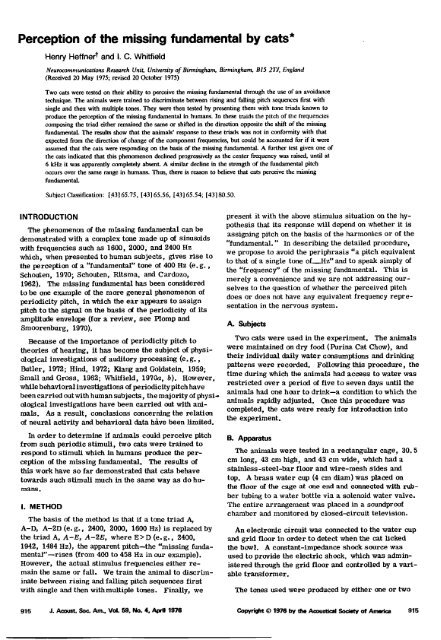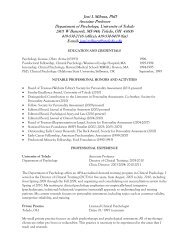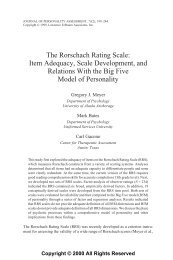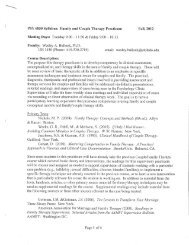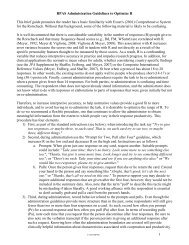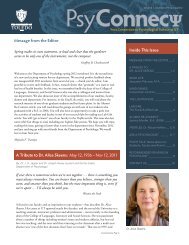Perception of the Missing Fundamental by Cats - Psychology
Perception of the Missing Fundamental by Cats - Psychology
Perception of the Missing Fundamental by Cats - Psychology
Create successful ePaper yourself
Turn your PDF publications into a flip-book with our unique Google optimized e-Paper software.
<strong>Perception</strong> <strong>of</strong> <strong>the</strong> missing fundamental <strong>by</strong> cats*Henry Heffner t and I. C. WhitfieldNeurocommunications Research Unit, University <strong>of</strong> Birmingham, Birmingham. BI$ 2TJ. England(Received 20 May 1975; revised 20 October 1975)Two cats were testexi on <strong>the</strong>ir ability to perceive <strong>the</strong> missing fundamental through <strong>the</strong> use <strong>of</strong> an avoidancetechnique. The an/msia were trained to discriminate between rising and falling pitch sequences first withsingle and <strong>the</strong>n with multiple tones. They were <strong>the</strong>n tested <strong>by</strong> presenting <strong>the</strong>m with tone triads known toproduce <strong>the</strong> p•rccption <strong>of</strong> <strong>the</strong> missing fundamental in humans. In <strong>the</strong>se traids <strong>the</strong> pitch <strong>of</strong> <strong>the</strong> frequenciescomposing <strong>the</strong> triad ei<strong>the</strong>r remained <strong>the</strong> same or shifted in <strong>the</strong> direction opposite <strong>the</strong> shift <strong>of</strong> <strong>the</strong> missingfundamental. The result show that <strong>the</strong> animals' response. to <strong>the</strong>se triads was not in conformity with thatexpected from <strong>the</strong> 'direction <strong>of</strong> change <strong>of</strong> <strong>the</strong> component frequencies, but could be accounted for if it wereassumed that <strong>the</strong> cats were responding<strong>the</strong> basis <strong>of</strong> <strong>the</strong> missing fundamental. A fur<strong>the</strong>r test given one <strong>of</strong><strong>the</strong> eats indicated that this phenomenon declined progressively as <strong>the</strong> center frequency was raised, until at6 kHz it was apparently completely absent. A similar decline in <strong>the</strong> strength <strong>of</strong> <strong>the</strong> fundamental pitchoccurs over <strong>the</strong> same range in humans. Thus, <strong>the</strong>re is reason to believe that cats perceive <strong>the</strong> missingfundamental.Subject Classification: [.43] 65.75, [43] 65.56, [43] 65.54; [43] 80.50.INTRODUCTIONThe phenomenon <strong>of</strong> <strong>the</strong> missing fundamental can bedemonstrated with a complex tone made up <strong>of</strong> sinusoldswith frequencies such as 1600, 2000, and 2400 Hzwhich, when presented to human subjects, g/yes rise to<strong>the</strong> perception <strong>of</strong> a "fundamental" tone <strong>of</strong> 400 Hz (e. go,Schouten, 19'/0; Schouten, Ritsma, and Cardozo,1962). The missing fundamental has been consideredto be one example <strong>of</strong> <strong>the</strong> more general phenomenon <strong>of</strong>periodicity pitch, in which <strong>the</strong> ear appears to assignpitch to <strong>the</strong> signal on <strong>the</strong> basis c/<strong>the</strong> periodicity <strong>of</strong> itsamplitude envelope (for a review, see 1•1omp andSmoorenburg, 1970).Because <strong>of</strong> <strong>the</strong> importance <strong>of</strong> periodicity pitch to<strong>the</strong>ories <strong>of</strong> hearing, it has become <strong>the</strong> subiect <strong>of</strong> physiologicalinvestigations <strong>of</strong> auditory processing (e. g.,Butler, 1972; Hind, 1972; Klang and Goldstein, 1959;Small and Gross, 1962; Whit/ield, 1970a, b). However,while behavioral investigations <strong>of</strong> periodicity pitch havebeen carried out with human subjects, <strong>the</strong> majority <strong>of</strong> physi-,ological investigations have been carried out with animais.As a result, conclusions concerning <strong>the</strong> relation<strong>of</strong> neural activity and behavioral data h•tve been limited.In order to determine if animals could perceive pitchfrom such periodic stimuli, two cats were trained torespond to stimuli which in humans produce <strong>the</strong> perceptiona[ <strong>the</strong> missing fundamental. The resttits <strong>of</strong>this work have so far demonstrated that cats behavetowards such stimuli much in <strong>the</strong> same way as do hu-I. METHODThe basis <strong>of</strong> <strong>the</strong> method is that if a tone triad A,A-D, A-2D (e.g., 2400, 2000, 1600 Hz)is repiaced <strong>by</strong><strong>the</strong> triad A, A-E, A-2E, where E > D (e.g., 2400,1942, 1484 Hz), <strong>the</strong> apparent pitch--<strong>the</strong> "missing fundamentai"--rises(from 400 to 458 Hz in our example).However, <strong>the</strong> actual stimulus frequencies ei<strong>the</strong>r remain<strong>the</strong> same or fall. We tra/n <strong>the</strong> animal to discrhn-inate between rising and rs/ling pitch sequences firstwith single and <strong>the</strong>n with multiple tones. Finally, wepresent it with <strong>the</strong> above stimulus situation on <strong>the</strong> hypo<strong>the</strong>sisthat its response will depend on whe<strong>the</strong>r it isassigning pitch on <strong>the</strong> basis <strong>of</strong> <strong>the</strong> harmonics or <strong>of</strong> <strong>the</strong>"fundamental." In describing <strong>the</strong> detailed procedure,we propose to avoid <strong>the</strong> periphrasis "a pitch equivalentto that <strong>of</strong> a single tone <strong>of</strong>__Hz" and to speak simply <strong>of</strong><strong>the</strong> "frequency" <strong>of</strong> <strong>the</strong> missing fundamental. This ismerely a convenience and we are not addressing ourselvesto <strong>the</strong> question <strong>of</strong> whe<strong>the</strong>r <strong>the</strong> perceived pitchdoes or does not have any equivalent frequency representationin <strong>the</strong> nervous system.A. SubjectsTwo cats were used in <strong>the</strong> experiment. The animalswere maintained on dry food (Purina Cat Chow), and<strong>the</strong>ir individual daily water consumptions and drinkingpatterns were recorded. Following this procedure, <strong>the</strong>time during which <strong>the</strong> animals had access to water wasrestricted over a period <strong>of</strong> five to seven days until <strong>the</strong>anitasis had one hour to drink--a condition to which <strong>the</strong>animals rapidly adjustedø Once this procedure wascompleted, <strong>the</strong> cats were ready for introduction into<strong>the</strong> experiment.B. ApparatusThe animals were tested in a rectangular cage, 30.5cm long, 43 cm high, and 43 cm wide, which had astainless-steel-bar floor and wire-mesh sides andtop. A brass water cup (4 cm diam) was placed on<strong>the</strong> floor o• <strong>the</strong> aa•e at one end and connected with rubbertubing to a water bottle via a solenoid water valve.The entire arrangement was placed in a soundpro<strong>of</strong>chamber and monitored <strong>by</strong> closed-circuit television.An electronic circuit was connected to <strong>the</strong> water cupand grid floor in order to detect when <strong>the</strong> cat licked<strong>the</strong> bowl. A constant-impedance shock source wasused to provide <strong>the</strong> electric shock, which was administeredthrough <strong>the</strong> grid floor and controlled <strong>by</strong> a variabletransformer.The tones used were produced <strong>by</strong> ei<strong>the</strong>r one or two915 J. Aeou•. So½. Am.. VoL 59, No. 4, Aiml 1976 Copyright ¸ 1976 <strong>by</strong> <strong>the</strong> Acoustical Society <strong>of</strong> America 915
916 Heffne• and Whitfield: <strong>Perception</strong> <strong>of</strong> <strong>the</strong> missing fundamental <strong>by</strong> cats 916TABLE I.Stimuli used in <strong>the</strong> missing fundamental test.Oscillators<strong>Missing</strong>A B Frequency fundamental(a) 342 ... 342 None400 ... 400 None458 ..- 458 None•) 342 1942 1600, 1942, 2284 342400 2000 1600, 2000, 2400 400458 2058 1600,2058, 2516 458(c) 342 2058 1716, 2058, 2400 342400 2000 1600,2000, 2400 400458 1942 1484, 1942, 2400 458DirectionFrequencyStandardUpDownStandardUpU pStandardDown<strong>of</strong> Change<strong>Missing</strong>fundamentalß ß ß'-'DownStandardUpDownStandardU pindependent ascillators and a balanced modulator. Toproduce <strong>the</strong> three-tone stimulus (triad), <strong>the</strong> output a/oscillator A was added to and subtracted from <strong>the</strong> centerfrequency produced <strong>by</strong> oscillator B and ali threefrequencies were combined. Th e frequency <strong>of</strong> oscillatorA thus determined <strong>the</strong> spacing <strong>of</strong> <strong>the</strong> three frequencies<strong>of</strong> <strong>the</strong> triad, and hence <strong>the</strong> frequency <strong>of</strong> <strong>the</strong>fundamental. By stepping <strong>the</strong> two oscillators throughequal increments <strong>of</strong> frequency, ei<strong>the</strong>r up or down andin <strong>the</strong> same or opposite directions, <strong>the</strong> four types <strong>of</strong> triedpairs set out below and inTable I couldbe produced.The transducers were a 7.5-cm paper-cone speaker(used only in <strong>the</strong> initial stage <strong>of</strong> training) and an ionicloudspeaker (Ionophane 601, Fane Acoustics, Ltd. )which were placed 0.5 m in front<strong>of</strong><strong>the</strong> animal and directedtowards its head. The advantages <strong>of</strong> <strong>the</strong> latterspeaker are that it has a linear response in <strong>the</strong> range<strong>of</strong> <strong>the</strong> frequencies used in this experiment and that<strong>the</strong>re is no moving diaphragm to generate distortionproducts. In addition, it is matched to <strong>the</strong> air <strong>by</strong> asmall horn such that <strong>the</strong> system has a high-pass characteristic,giving considerable attenuation for frequenciesin <strong>the</strong> region below 1 kHz.Sound measurements were made <strong>by</strong> placing a microphone(Briiel& Kj•er «-in. model 4133) above <strong>the</strong> watercup in <strong>the</strong> position previously occupied <strong>by</strong> <strong>the</strong> cat's headand with its axis pointing directly at <strong>the</strong> loudspeaker.The sound level was measured with a Briiel & Kj•ermicrophone amplifier (model 2604) and •-octave filter(model 1614). Readings for <strong>the</strong> 1600, 2000, 2400 Hztriad were 63, 70, and 65 dB with <strong>the</strong> filters centeredon 1600, 2000, and 2500 Hz, respectively.Because <strong>of</strong> <strong>the</strong>ir small separation, <strong>the</strong> three components<strong>of</strong> a triad are not completely resolved <strong>by</strong> <strong>the</strong>filter system, so that adjacent components contributeto each reading.. The readings obtained would correspondto values for <strong>the</strong> respective components <strong>of</strong> about62, 68, and 64 dB SPL. In general and on this basis,<strong>the</strong> intensities <strong>of</strong> <strong>the</strong> components <strong>of</strong> <strong>the</strong> various triadsall fell within <strong>the</strong> range 65+3 dB SPL. No output couldbe detected within <strong>the</strong> band 12.5-1000 Hz.C. StimuliThe stimulus pairs were composed <strong>of</strong> ei<strong>the</strong>r singletones or triads in which <strong>the</strong> "standard" stimulus wasfollowed <strong>by</strong> a "comparison" stimulus <strong>of</strong> ei<strong>the</strong>r higheror lower frequency (Fig. 1)o The tone pairs were presentedat a rate <strong>of</strong> one pair/sec for 10 sec (290-msecduration, 20-msec rise-decay, with 10 msec betweenmembers <strong>of</strong> a pair and 410 msec between pairs). Thestimuli used may be divided into three categories (cf.Table I).(a) A standard tone <strong>of</strong> 400 Hz followed <strong>by</strong> a comparisontone c• ei<strong>the</strong>r 342 or 458 Hz [Table I(a)].(b) A standard triad <strong>of</strong> 1600, 2000, 2400 Hz followed<strong>by</strong> a comparison triad <strong>of</strong> ei<strong>the</strong>r 1600, 1942, and 2284Hz or 1600, 2058, and 2516 Hz [Table I(b)]. In humam<strong>the</strong>se triads produce <strong>the</strong> perception <strong>of</strong> a fundamentaltone (<strong>the</strong> missing fundamental) c• 400, 342, and458 Hz, respectivelyø It is important to no•e that when<strong>the</strong> standard triad is paired with ei<strong>the</strong>r <strong>of</strong> <strong>the</strong> two comparisontriads, <strong>the</strong> frequencies <strong>of</strong> both <strong>the</strong> triad and<strong>the</strong> missing fundamental change in <strong>the</strong> same directionrelative to <strong>the</strong> standard.(c) A standard triad <strong>of</strong> 1600, 2000, and 2400 Hzfollowed <strong>by</strong> a comparison triad <strong>of</strong> ei<strong>the</strong>r 1716, 2058,and 2400 Hz or 1484, 1942, and 2400 Hz [Table I(c)].fTANDARO ]z•JuJu.STANDARD''SAFEI 9 10WARNINGI 9 I0TIME ( sec )FIG. 1. Schematic representation <strong>of</strong> <strong>the</strong> tone pairs used in <strong>the</strong>missing fundamental test. The safe signal consisted <strong>of</strong> 10 tonepairs in which <strong>the</strong> second tone <strong>of</strong> each pair was <strong>of</strong> lower frequencythan <strong>the</strong> first or standard tone, The warning signalconsisted <strong>of</strong> 10 tone pairs in which <strong>the</strong> second tone was <strong>of</strong> higherfrequency than <strong>the</strong> standard. The animals were trained tomake an avoidance response upon presentation <strong>of</strong> <strong>the</strong> warningsignal and to ignore <strong>the</strong> safe signal.'J. Acou•t. So•. Am., VoL Eg, No. 4, April 1976
917 Heffner and Whitfield: <strong>Perception</strong> <strong>of</strong> <strong>the</strong> missing fundamental <strong>by</strong> c;ts 917•n this case, <strong>the</strong> frequencies <strong>of</strong> <strong>the</strong> triads and<strong>the</strong>missingfundamental produced <strong>by</strong> <strong>the</strong> triads change in <strong>the</strong>opposite direction relative to <strong>the</strong> standard. Thus, forexample, a person who perceived <strong>the</strong> missing fundamentalwould say that <strong>the</strong> comparison tone <strong>of</strong> <strong>the</strong> pairwas <strong>of</strong> higher frequency than <strong>the</strong> standard when in facttwo <strong>of</strong> <strong>the</strong> tones in <strong>the</strong> triad were lower. This stimulnscondition was <strong>the</strong>refore crucial in determining whe<strong>the</strong>ra subject perceived <strong>the</strong> missing fundamental.During initial training, it was discovered that <strong>the</strong>cats tended to respond to changes in <strong>the</strong> absolute frequency<strong>of</strong> <strong>the</strong> tones as well as to <strong>the</strong> direction <strong>of</strong> <strong>the</strong>shift in pitch. To reduce <strong>the</strong> possibility <strong>of</strong> an animalresponding to changes in absolute frequency, <strong>the</strong> settings<strong>of</strong> <strong>the</strong> two oscillators were randomly varied <strong>by</strong>as much as 10% for <strong>the</strong> stimuli listed in categories (a)and (b) [but not (c)]. This procedure also served to reduce<strong>the</strong> possibility that <strong>the</strong> task could be solved on <strong>the</strong>basis <strong>of</strong> changes in intensity which might have beenassociated with changes in frequency.O. Procedure.Briefly, <strong>the</strong> cats were trained to maintain contactwith <strong>the</strong> water cup for a water reward. After a reasonablysteady rate <strong>of</strong> contact was attained, trials werebegun which consisted <strong>of</strong> <strong>the</strong> presentation <strong>of</strong> one <strong>of</strong> twotone patterns for 10 sec. - If <strong>the</strong> tone pattern had arising pitch sequence, <strong>the</strong> cat had to cease licking within3 sec <strong>of</strong> tone onset in order to avoid an electricshock which would o<strong>the</strong>rwise be delivered to <strong>the</strong> ani-mal's feet at tone <strong>of</strong>fset. This conditioning proceduresoon resulted in a cessation <strong>of</strong> contact with <strong>the</strong> cupduring such a trial. However, if <strong>the</strong> tone pattern hada falling pitch sequence, it was never followed <strong>by</strong> shockand cats soon learned to maintain contact with <strong>the</strong> cupduring <strong>the</strong>se trials. Evidence that <strong>the</strong> cats had learned<strong>the</strong> discrimination was provided <strong>by</strong> demonstrating that<strong>the</strong> animals broke contact when a rising pitch sequencewas presented and maintained contact when a falling ßpitch sequence was presented.1. Details <strong>of</strong> training and testingThe cats were piaced in <strong>the</strong> cage for a period <strong>of</strong> oneho•r and allowed to drink from <strong>the</strong> water cup. Waterwas delivered into <strong>the</strong> cup at a rate <strong>of</strong> 100 drops/turn(00 025 ml/drop) as long as <strong>the</strong> animal maintained contactwith <strong>the</strong> cup. If <strong>the</strong> animal broke contact with <strong>the</strong>cup for more than 0.25 sec, <strong>the</strong> flow <strong>of</strong> water wasautomatically stopped. As a reset, <strong>the</strong> cats soonlearned that steady contact with <strong>the</strong> cup would deliver<strong>the</strong> maximum amount <strong>of</strong> water.Once <strong>the</strong> animal had learned to maintain constantcontact with <strong>the</strong> water cup, a four-stage training andtesting procedure was begun.First stage: The 400-458-Hz tone pairs were presentedfor 10 sec and, unless <strong>the</strong> animaI ceased drinkingwithin 3 sec <strong>of</strong> tone onset, were followed at <strong>the</strong> end<strong>of</strong> <strong>the</strong> 10-sec period <strong>by</strong> an electric shock deliveredthrough <strong>the</strong> grill floor. After several such tone-shockpairings, <strong>the</strong> cats learned to cease drinking when <strong>the</strong>"warning" stimulus came on and thus were usually ableto avoid <strong>the</strong> shock. The warning stimulus was presentedat random intervals varying in 15-sec blocksfrom 45 to 180 sec following <strong>the</strong> previous warning signal.Thus, <strong>the</strong>re were generally 10 intervals in whicha warning signal could occur (i.e., 45, 60, 75 .... ,180 sec) though longer intervals were occasionallyinserted.Second stage: Once <strong>the</strong> cats had learned to avoid<strong>the</strong> 400-458-Hz tone pair, <strong>the</strong>y were trained to ignore<strong>the</strong> 400-343-Hz tone pair, <strong>the</strong> "safe" signal [TableI(a)]. This was accompUshed <strong>by</strong> presenting this tonepair during <strong>the</strong> 10-sec intervals in which a warningsignal might have, but did not, occur. Thus, <strong>the</strong> catswere continuously presented with 10-sec tone pairsseparated <strong>by</strong> 5 sec <strong>of</strong> silence, with <strong>the</strong> warning signalrandomly interspersed among <strong>the</strong> safe signals. Thisstage <strong>of</strong> training was completed in approximately 20sessions.Third stage: When <strong>the</strong> cats had learned to discriminatereliably between <strong>the</strong> two signals, <strong>the</strong> triad pairs[Table I(b)] were introduced. The procedure used herewas <strong>the</strong> same as in stage 2 in that <strong>the</strong> animals weretrained to avoid <strong>the</strong> triad pair in which <strong>the</strong> pitch se~quence <strong>of</strong> <strong>the</strong> component frequencies, as well as <strong>the</strong>missing fundamental, was rising and to ignore <strong>the</strong>triads in which <strong>the</strong> pitch sequence <strong>of</strong> <strong>the</strong> componentfrequencies and <strong>the</strong> missing fundamental were falling.Though <strong>the</strong> anitasis learned to perform this discriminationwithin three to five sessions, training was continueduntil <strong>the</strong> animals had received at least 20 train-ing sessions.Fourth stage: When <strong>the</strong> cats had learnedtodiscriminate<strong>the</strong> triad pairs, <strong>the</strong>y were presented with <strong>the</strong> testfor <strong>the</strong> perception <strong>of</strong> <strong>the</strong> missing fundamental. Thisconsisted <strong>of</strong> presenting "test" triad pairs iTshie I(c)]in which <strong>the</strong> pitch sequence <strong>of</strong> <strong>the</strong> component frequencieswas in <strong>the</strong> direction opposite <strong>the</strong> pitch sequence•g <strong>the</strong> missing fundamental.The test triads were presented <strong>by</strong> inserting <strong>the</strong>mwithin sessions consisting primarily <strong>of</strong> <strong>the</strong> originaltriads with which <strong>the</strong> animals had been trained. Since<strong>the</strong> nature <strong>of</strong> <strong>the</strong>se test triads (i.e., safe or warning)depended upon <strong>the</strong> cue <strong>the</strong> animal was using, <strong>the</strong>setriads were never followed <strong>by</strong> shock regardless <strong>of</strong> <strong>the</strong>animal's response. Testing was complete once ananimal had received 10 <strong>of</strong> each <strong>of</strong> <strong>the</strong> two test triadsfor a total <strong>of</strong> 20 test trials.For comparison, <strong>the</strong>performance <strong>of</strong> <strong>the</strong> cats on <strong>the</strong> original training tri•lswas determined on <strong>the</strong> basis <strong>of</strong> <strong>the</strong> 60-80 trials which.<strong>the</strong>y received during <strong>the</strong> test sessions. A fur<strong>the</strong>r testwas given cat 2 to determine <strong>the</strong> range <strong>of</strong> frequenciesover which <strong>the</strong> missing fundamental might be perceived.This test consisted <strong>of</strong> triads in which <strong>the</strong> center frequencywas 3, 4, 5, or 6 kHz and <strong>the</strong> upper and lowerfrequencies were <strong>the</strong> center frequency plus and minus400 Hz. To produce <strong>the</strong> comparison frequencies, <strong>the</strong>nsciliator outputs were increased and decreased <strong>by</strong>58 Hz, as in <strong>the</strong> 2-kHz center frequency test.J. Acoutt. Soc. Am., Vol. 59, No. 4, April 1976
918 Heffner and Whitfield: <strong>Perception</strong> <strong>of</strong> <strong>the</strong> miss'ng fundamental <strong>by</strong> cats 918TABLE IL Performance on 2-kHz center frequency missingfundamental test, Low scores indicate a cessation <strong>of</strong> contactwith <strong>the</strong> water cup in order to avoid electric shock. Theletters "b" and "c" indicate <strong>the</strong> section <strong>of</strong> Table I from which<strong>the</strong> stimuli were drawn. Note that <strong>the</strong> animals showed avoidancebehavior when <strong>the</strong> missing fundamental warned <strong>of</strong> possibleshock even though <strong>the</strong> frequencies <strong>of</strong> <strong>the</strong> triad indicated noshock (c).<strong>Missing</strong>ConditionScore (in sec)fundamental Triad Cat 1 Cat 2•o) Safe Safe 9.2 9.7Warning Warning 3.2 3.3(c) Safe Warning 9.6 9.7Warning Safe 4.8 3.02. Analysis <strong>of</strong> behavioral dataThe amount <strong>of</strong> time that an animal maintained con-tact with <strong>the</strong> water cup during <strong>the</strong> safe and warningintervals was determined to <strong>the</strong> nearest 0.1 sec. Thus,<strong>the</strong> time or score for an individual trial could varyfrom 0 to 10.0. To reduce <strong>the</strong> effects <strong>of</strong> spuriouspauses, <strong>the</strong> results <strong>of</strong> a trial were discarded if <strong>the</strong>animal broke contact during <strong>the</strong> 2 sec preceding atrial, though <strong>the</strong> trial was presented as usual. Thisprocedure helped reduce variability <strong>by</strong> eliminatingtrials presented while an animal was pausing to groomor rest, as <strong>the</strong>y occasionally did, without having toresort to modification <strong>of</strong> <strong>the</strong> randomized trial presentationssequence. Because this criterion was appliedequally to safe and warning trials, it did not bias <strong>the</strong>results. The scores for <strong>the</strong> safe and warning trialswere compared using <strong>the</strong> Mann-Whitney U test (Sisgal,1956) to determine <strong>the</strong> probability that <strong>the</strong> animalswere successfully performing <strong>the</strong> discrimination.To compare <strong>the</strong> performance <strong>of</strong> cat 2 as <strong>the</strong> centerfrequency was varied, a unitless measure <strong>of</strong> detectionwas chosen. This measure is a function <strong>of</strong> <strong>the</strong> lengthcf time <strong>the</strong> animal mainixined contact during <strong>the</strong> warning(W) and safe (S) signals and is computed as (S- W)/S.The values <strong>of</strong> <strong>the</strong> measure vary from + 1 (indicatingcomplete cessation <strong>of</strong> drinking during <strong>the</strong> warning signal)to 0 (indicating no cessation <strong>of</strong> drinking), with intermediatevafues interpreted as indicating that <strong>the</strong>warning signal was sometimes detected (e.g., Heffner,H•/fner, and Masterton, 1971).II.RESULTSThe performance <strong>of</strong> <strong>the</strong> two cats during <strong>the</strong> test sessionsis shown in Table llo When both <strong>the</strong> missing fundamentaland <strong>the</strong> component frequencies <strong>of</strong> <strong>the</strong> triadwere safe signals [Table II(b)] <strong>the</strong> animals generallycontinued to drink from <strong>the</strong> water cup with litfie orno pause. Indeed, though on <strong>the</strong> average <strong>the</strong> animalsbroke contact with <strong>the</strong> cup for less than I sec, <strong>the</strong> catsshowed no break in contact at all on over half <strong>of</strong> <strong>the</strong>safe trials. Thus, <strong>the</strong> animals had learned not to respondto a falling pitch sequence. In contrast, whenboth <strong>the</strong> missing fundamental and <strong>the</strong> component fre-quencies indicated shock, <strong>the</strong> animais ceased drinkingfrom <strong>the</strong> water cup in an average time <strong>of</strong> 3 to 4 sec.In addition, <strong>the</strong> median score for each animal was lessthan 3 sec, so that on most <strong>of</strong> <strong>the</strong> warning trials <strong>the</strong>animals did not receive a shock at <strong>the</strong> end <strong>of</strong> <strong>the</strong> 10-sectrial. Thus, <strong>the</strong> distribution <strong>of</strong> <strong>the</strong> animals' scoresindicated that <strong>the</strong>y had learned to distinguish a risingfrom a fallir•g pitch sequence (p < 0.0001, one-taileddistribution).The scores for <strong>the</strong> triais in which <strong>the</strong> direction <strong>of</strong><strong>the</strong> pitch sequence <strong>of</strong> <strong>the</strong> missing fundamental was 09-pusitc to that <strong>of</strong> <strong>the</strong> component frequencies are shown.in Table II(c). Note that both animals maintained contactwhen <strong>the</strong> missing fundamental indicated a safe trialand broke contact when it indicated a warning trial(p < 0.002, two-tailed distribution). Indeed, <strong>the</strong> performances<strong>of</strong> <strong>the</strong> animals were so consistent that <strong>the</strong>distributions <strong>of</strong> <strong>the</strong> safe and warning scores did notoverlap. This result suggests that <strong>the</strong> cats were notresponding to <strong>the</strong> component frequencies <strong>of</strong> <strong>the</strong> triadand may have been responding to<strong>the</strong> missingfundamental.The investigation <strong>of</strong> <strong>the</strong> missing fundamental in humanshas suggested that <strong>the</strong> phenomenon does not occurfor center frequencies above about 5 kHz (Schouten,1070). To fur<strong>the</strong>r explore <strong>the</strong> ability <strong>of</strong> cats to respondto <strong>the</strong>se signals, cat 2 was tested using triadswith center frequencies <strong>of</strong> 3, 4, 5, and 6 kHz.Figure 2 shows <strong>the</strong> performance <strong>of</strong> <strong>the</strong> animal when<strong>the</strong> missing fundamental and <strong>the</strong> triad signaled <strong>the</strong> samecondition (i.e., both indicated safe or warning) andwhen <strong>the</strong>y signaled opposite conditions. The decline inperformance in <strong>the</strong> latter condition indicates that whatevercue <strong>the</strong> animal was relying an at 2 kHz (<strong>the</strong> missingfundamental in our hypo<strong>the</strong>sis) is progressivelylost as <strong>the</strong> center frequency is raised, until at 6 kHzperformance ts not above chance. There was a paralleldecline in performance when <strong>the</strong> missing fundamentaland triad indicated <strong>the</strong> same condition, suggesting0-80-4CAT - 20-2 S2 3 4 5 6CENTER FREQUENCY (kHz)FIG. 2. Performance <strong>of</strong> cat 2 on <strong>the</strong> missing fundamental testusing center frequencies <strong>of</strong> 2, 3, 4, 5, and 6 kHz. Scoreswere abtained under two conditions: <strong>the</strong> missing fundamentaland <strong>the</strong> frequencies composing <strong>the</strong> trials shifting in <strong>the</strong>same (S) and opposite (O) directions. Note that performancein both conditions declines as center frequency is increased.(ns indicates that performance was not above chance, p > 0.05. ),J. Acoust. Soc. Am., VoL 59, No. 4, April 1976
919 Heftnet and Whitfield: <strong>Perception</strong> <strong>of</strong> <strong>the</strong> missing fundamental <strong>by</strong> cats 919that <strong>the</strong> animal does not switch to using <strong>the</strong> componentfrequencies when <strong>the</strong> fundamental cue disappears.III.DISCUSSIONThe results <strong>of</strong> this study strongly suggest that catsexperience something similar to, if not identical with,<strong>the</strong> perception <strong>of</strong> <strong>the</strong> missing fundamental in humans.The response <strong>of</strong> <strong>the</strong> animals in <strong>the</strong> test condition wasnot in conformity with that expected from <strong>the</strong> direction<strong>of</strong> change <strong>of</strong> <strong>the</strong> component frequencies <strong>of</strong> <strong>the</strong> triads,since, contrary to o<strong>the</strong>r training, <strong>the</strong> animals avoidedwhen <strong>the</strong> direction <strong>of</strong> <strong>the</strong> test signal was down and failedto avoid when it was up. However, <strong>the</strong>ir performancecould be accounted for if it were assumed that <strong>the</strong> catswere responding on <strong>the</strong> basis <strong>of</strong> a phenomenon in which<strong>the</strong> direction <strong>of</strong> pitch change was that <strong>of</strong> <strong>the</strong> missing fundamental.The additional tests given to cat 2 show a fur<strong>the</strong>rparallel with results in humans. In <strong>the</strong> "opposition"situation where a correct response requires attentionto <strong>the</strong> missing fundamental cue, performance declinedprogressively as <strong>the</strong> center frequency was raised, untilat 6 kHz it was apparently completely absent. Inhumans <strong>the</strong>re is a similar decline in <strong>the</strong> strength <strong>of</strong><strong>the</strong> fundamental pitch over about <strong>the</strong> same range (e. g.,Sohourea, 1970).The entirely similar decline in performance <strong>by</strong> cat2 when <strong>the</strong> triads and <strong>the</strong> missing fundamental movedin <strong>the</strong> same direction suggests that <strong>the</strong> animal was unableto switch from <strong>the</strong> fundamental to <strong>the</strong> triad fre-quencies as <strong>the</strong> former declined. This fur<strong>the</strong>r suggesisthat <strong>the</strong> animals were not using <strong>the</strong> triad frequenciesin any <strong>of</strong> <strong>the</strong> experimental situations, but that<strong>the</strong>y always heard <strong>the</strong> pitch in <strong>the</strong> earlier experimentsas corresponding to that <strong>of</strong> <strong>the</strong> missing fundamental.It is necessary, <strong>of</strong> course, to consider <strong>the</strong> possibilitythat while <strong>the</strong>re was no detectable external signalbelow 1 kHz, <strong>the</strong> animals could have been respondingto an intra-aurally generated difference tone. Plomp(1965) found that in man a difference tone <strong>of</strong> 400 Hz in<strong>the</strong> midsing fundamental situation was just detectablewhen <strong>the</strong> intensity cg <strong>the</strong> harmonics forming <strong>the</strong> complexreached a level <strong>of</strong> about 70 dB SPL, <strong>the</strong>re beinga good deal c• scatter between subjects. It is, however,begging <strong>the</strong> question to use human data in this contextand some intern,M evidence is to be preferred. Wesuggest that this might come also from <strong>the</strong> experimentswith higher center frequencies. Had <strong>the</strong> animals beenresponding to difference tones, <strong>the</strong>y might well havebeen expected to do so whe<strong>the</strong>r <strong>the</strong>se were generatedwith a 2- or a 5-kHz centerfrequency. To account for<strong>the</strong>ir actual behavior in such circumstances, it wouldbe necessary to postulate that <strong>the</strong> way <strong>the</strong> cat ear generatesdifference tones happens to decline with generatingfrequency in just <strong>the</strong> same way that <strong>the</strong> missingfundamental declines in man. A more realistic conclusionis that <strong>the</strong> animals were not able to use differ-ence tones to solve <strong>the</strong> problem.The discovery that cats may be able to perceive <strong>the</strong>missing fundamental is encouraging for <strong>the</strong> study <strong>of</strong>auditory processing, because it suggests that <strong>the</strong> auditorysystem <strong>of</strong> cats is similar in this respect to <strong>the</strong>human auditory system. As a result, it may be possibteto compare <strong>the</strong> extensive data concerning psriodicitypitch ga<strong>the</strong>red through p•ychophysical studieson humans with <strong>the</strong> physiological data concerning <strong>the</strong>auditory system obtained in <strong>the</strong> cat. Such comparisonscan <strong>the</strong>n be used to determine <strong>the</strong> physiological mechanismswhich underlie <strong>the</strong> psychological phenomena<strong>of</strong> hearing. Though fur<strong>the</strong>r investigation is needed toestablish that <strong>the</strong> phenomenon observed in cats is identicalin every respect to that in man, we have at thistime no reason not to believe that cats do indeed perceive<strong>the</strong> missing fundamental.*This work was supported <strong>by</strong> a grant from <strong>the</strong> Science ResearchCouncil.tCurreut address: Bureau <strong>of</strong> Child Research, Parsons StateHospital and Training Center, Parsons, KS 67357.Butler, R. A. (1972). "The auditory evoked response to stimuliproducing periodicity pitch," Psychephysiology 9, 233-237.Heftnor, R., Heftnor, H., and Masterton, B. (1971). "Behavioralmeasurements <strong>of</strong> absolute and frequency-differencethresholds in guinea pig," J. Acoast. Sec. Am. 49, 1888-1895.Hind, J.E. (1972). "t'hysiological correlates <strong>of</strong> auditory stimulusperiodicity, "A udiology 11, 42-57.Kiang, N. Y-S., and Goldstein, M. H. (1959). "Tenetopic organization<strong>of</strong> <strong>the</strong> cat auditory cortex for some complex stimuli,"J. Acoust. Sec. Am. 31, 786-790.Pierap, R. (1965). "Detectability threshold for combinationtones," J. Acoust. Sec. Am. 37, 1110-1123.Pierap, R., and Smoorenburg, G. F., Eds. (1970). FrequencyAnalysis and Periodicity Detection in Hearing (Sijth<strong>of</strong>f, Leizion,The Ne<strong>the</strong>rlands).Sohourea, J. ¾., (1979). "The residue revisited," in FrequencyAnalysis and Periodicity Detection in Hearing, edited<strong>by</strong> R. Plomp and G. F. Smoorenburg (Sijth<strong>of</strong>f, Leiden, TheNe<strong>the</strong>rlands), pp. 41-54.Schouten, J. F., Ritsma, R. J., and Cardoze, B. L. (1962)."Pitch <strong>of</strong> <strong>the</strong> residue," J. Acoust. Sec. Am. 34, 1418-1424.Siegel, S. (1956). Nonpara,r, etric Statistics (McGraw-Hill,New York).Small, A.M. R., and Gross, N. B. (1962). "Response <strong>of</strong> <strong>the</strong>cerebral cortex <strong>of</strong> <strong>the</strong> cat to repetitive acoustic stimuli," J.Conap. Physio[. Psychol. 55, 445--448.Whitfield, I. C. (1970a). "Neural integration and pitch perception,"in E•cltatory Synal)tic Mechanisms, edited <strong>by</strong> P. Andersenand J. K. S. Jansen (Universitetsforlaget, Oslo),pp. 277-285.Whitfield, I. C. (1970b). "Can nerve impulse periodicity beused for pitch perception?" in Ciba Foundation Symposium onSe•zsorin½•'al HearingLoss, edited <strong>by</strong> G. E. W. Wolstenho[meand J. Knight (Churchill, London), pp. 213-223.J. Aooust. Soc. Am., Vol. 59, No. 4, April 1976


